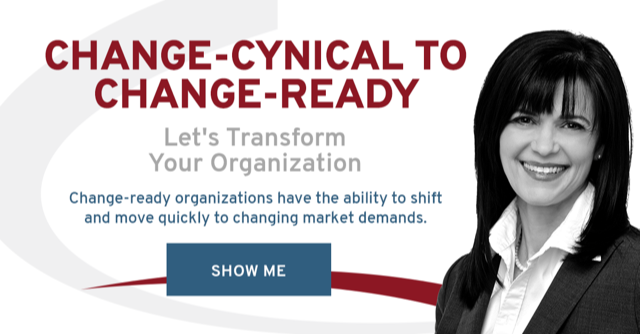Overcoming The Most Difficult Aspect of Change: Letting Go
Dr. Dawn-Marie Turner
After almost 20 years, I switched from my Blackberry smartphone to an iPhone.
I was ready.
I knew it would take time to learn the new technology, but I was surprised that letting go of the old phone was so uncomfortable. I shouldn’t have been surprised though. Letting go of our current state is one of the most difficult aspects of any change. A lack of leadership through this necessary step is one reason organizational change fails.
The good news is there are things we can do to make letting go easier.
The Discomfort of Change
Every change is uncomfortable. Whether the change is like mine, self-initiated. Or whether someone else or circumstance initiated the change.
Change is uncomfortable because it is change. Change is any situation, event, or circumstance that enables, allows, pushes, forces, or requires you to leave your comfort zone. So, by definition to be change it must be uncomfortable.
 We feel the discomfort of change the most when faced with letting go of what we know. There is good reason for this. To move toward any change we must leave the familiarity of something we know before we are sure the new situation will become comfortable. This puts us in a kind of no man’s land.
We feel the discomfort of change the most when faced with letting go of what we know. There is good reason for this. To move toward any change we must leave the familiarity of something we know before we are sure the new situation will become comfortable. This puts us in a kind of no man’s land.
William Bridges called this space the neutral zone. He described it as the space where our old ways or activities don’t exist, but the new ways have not yet become our normal. For me this space is the “guts of the change”. Because it’s in this space we really feel the discomfort, and uncertainty deep within our gut. We can’t go back, but going forward feels so uncomfortable. We begin to question the validity of the change and the outcome. Why are we doing this? Is it really needed? What are we looking to achieve? Is it worth it?
It doesn’t matter how much we want or need the change, or the benefits we see, letting go is uncomfortable. It’s helpful for leaders to remember this when initiating organizational change. Leaders are often surprised by employees’ unwillingness to let go. This is especially confusing for leaders when they believe they are initiating a change their employees wanted.
Comfy Shoe Syndrome
Leaders who are launching a change often tell me, the change will be easy, everyone wants it. When this happens, I caution them to beware of the “comfy shoe syndrome”.
Comfy shoe syndrome happens when your old shoes have worn out. You knew they needed to be replaced. You buy new shoes.
You’re excited, and pleased.
You throw away your old shoes. But the new ones aren’t as comfortable as your old ones. They don’t mold to your foot like your old ones, they pinch a little, and the leather isn’t as soft. You start complaining about the new shoes. You wish you hadn’t gotten rid of your old shoes. Your focus is on the loss rather than on the benefits of the new shoes.
That’s what happened to me with my new smartphone. I knew my phone needed to be replaced. I wanted and believed I needed to make the switch. I left the store excited. I set up my phone quickly and was looking forward to all its new features.
Like those new shoes, the phone didn’t fit as comfortably with my current work practices. Some of the features I liked on my old phone weren’t available on the new phone. I believed the phone would increase my productivity, and make things easier. But initially the phone made things more difficult. I lost productivity while getting used to the new features. I had to manually do things my old phone did automatically.
I reminisced about what my old phone could do. I complained about having to change work habits and practices to integrate the new technology. I even thought about going back.
I didn’t. But I thought about it.
I see similar with organizational change. In one organization the employees had been complaining for years about one particular piece of software. They greeted the announcement of its replacement with statements like “finally”, “yeah”, “it’s about time”.
However, it didn’t take long before they were complaining about the new system. They talked about all the things the old system could do that the new one couldn’t. Leaders were lulled into feeling the change would be easy because everyone wanted it. They were caught by surprise with the complaints and the level of disruption.

The comfy shoe syndrome is a normal part of our process. It’s actually an indicator that your change is moving forward. William Bridges notes that although difficult, the neutral zone is where real change begins. It’s in this space people turn their awareness or buy-in for the change into the commitment needed for sustainable change.
Unfortunately, leaders who disregard the discomfort of letting go or are unaware it exists can erroneously label the reminiscing and complaints as resistance. Stalling out the change process.
What can you do?
Acknowledge and allow time for people to let go. As soon as we take that first step of letting go we cross over into the Whitespace. Those first few steps we take as we cross over into the Whitespace are filled with uncertainty. In the beginning it’s like being out at sea on a sailboat. We have left the safety of the shore, we can’t yet see the new shore, and we are learning how to sail.
Recognize the complaints & reminiscing are a normal part of the process. That doesn’t mean you can ignore them or write them off as simply resistance. There is often useful and important information in these conversations. Sometimes these conversations raise serious risks that can’t and shouldn’t be ignored. Actively listen to the conversations. This will give you insight into the change event and what is needed to support your employees.
Balance the ending with a meaningful beginning. In the early part of any change there is a tendency to focus on what is being loss, (the ending). It’s helpful for leaders to help people see the change is not either an ending or a beginning, but both. Every change is both an ending and a beginning. In the early phases leaders can help employees refocus on the new state, and its benefits. To do this you need make the time to create, document and share the intended outcome. Ensure it’s clear, concrete, and compelling for the change. Provide your employees with the time and opportunity to explore the outcome. Letting go will be easier if the outcome is meaningful, and desired.
I am in new steady state with my iPhone. It’s fully integrated, and I have no desire to go back.



